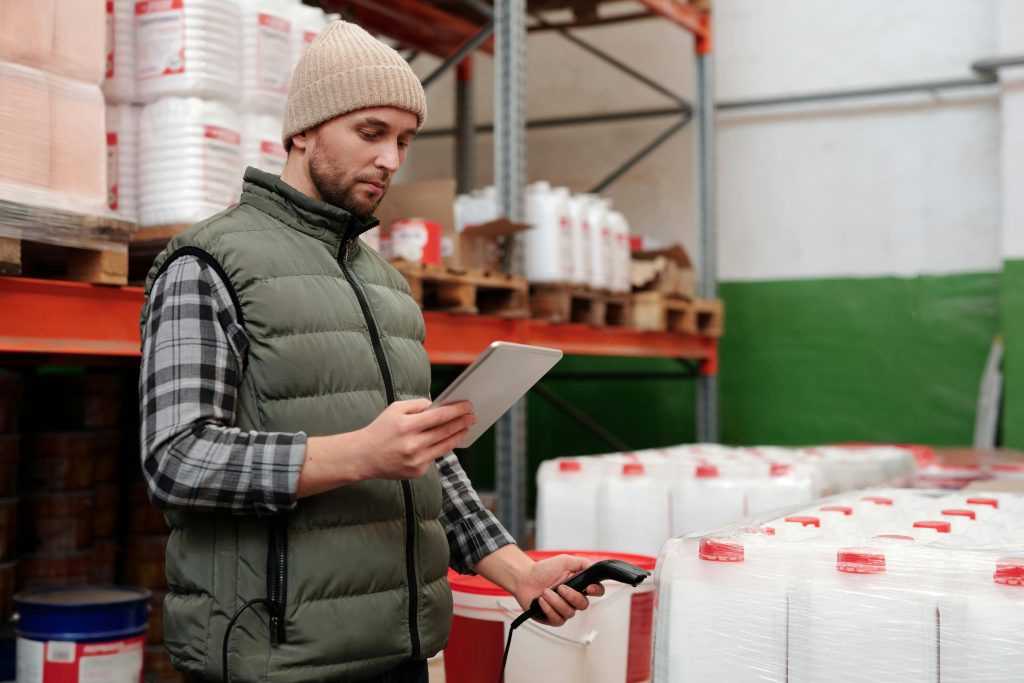Moving from clipboards and manual key entry to barcode-driven inventory control is one of the highest-ROI operational upgrades most product businesses can make. With barcoding in place, you reduce data entry errors, improve stock accuracy, accelerate receiving and picking, enable real-time visibility, and lay the groundwork for automation (directed putaway, replenishment triggers, cycle count scheduling, even robotics later). Whether you run a growing ecommerce fulfillment center, a light manufacturing plant, a wholesale distribution operation, or a small back-room stock area that’s outgrown spreadsheets, this guide walks you step by step through what to barcode, how to label it, which hardware and software you need, how to integrate scanning into warehouse processes, and how to roll it out without disrupting operations—all without external links.

Why Barcode-Driven Inventory Control Beats Manual Methods
Speed: Scanning replaces typing 8–20 characters per SKU. Multiply by thousands of touches per day and you reclaim labor immediately.
Accuracy: Keying errors (transposed digits, wrong location codes) drive mis-picks and stock discrepancies. Scanners validate data at scan time.
Traceability: Scanning at every movement creates a transaction history—critical for recalls, lot/expiry tracking, and financial audits.
Visibility: Real-time updates feed dashboards, reorder points, and sales channels, reducing oversell/backorders.
Scalability: Once labeled, items flow through automated workflows, RF-directed tasks, cartonization logic, or mobile apps with minimal reconfiguration.
Core Building Blocks: What Data Needs a Barcode?
You can barcode almost anything—but start with the data objects that matter most to inventory accuracy and movement control.
| Data Object | Why Barcode It | Typical Code Data | Notes |
|---|---|---|---|
| Item / SKU | Identify product across all processes | SKU code (prefer short) | Map to UoM; may embed variant (size/color). |
| Location | Know where stock lives | Location ID (aisle-bay-level-bin) | Scan on putaway, picking, cycle counts. |
| License Plate / Container ID | Track cases, totes, pallets as movable units | Unique ID (e.g., LPN000123) | Speeds bulk moves; reduces each-level scans. |
| Lot / Batch / Expiry | Traceability, FIFO/FEFO | Lot code + date | Use 2D codes or separate fields if long. |
| Serial Number | Item-level traceability | Serial | Often scanned at ship/install. |
| Documents | Link paperwork to system transaction | ASN #, PO #, Pick ticket # | Lets workers pull correct record instantly. |
Start small: SKU + location barcodes often deliver 70% of the benefit. Then layer license plates, lots, and documents as maturity grows.
Barcode Symbologies: Choosing the Right One
Not all barcodes are created equal. Select the symbology that matches your data length, scan environment, and print quality.
1D (Linear) Codes
- Code 128: Workhorse; dense, alphanumeric, compact; widely supported. Great default.
- Code 39: Older, larger; still common in manufacturing. Accepts letters; less space efficient.
- UPC / EAN: Retail point-of-sale barcodes printed by manufacturers. If receiving consumer goods, scan what’s already there for item ID, but still create internal location/LPN labels.
2D Codes
- Data Matrix: Very compact; good for small parts, electronics, direct part marking, and high data density (lot/serial/expiry).
- QR Code: Readable by phones; larger footprint; good for field service, documents, supplier info links.
- PDF417: Stacked linear; high data capacity; used in logistics docs and ID cards.
Rule of Thumb: Use 1D Code 128 for most warehouse labeling; move to 2D when you must encode multiple fields (e.g., GS1 application identifiers for GTIN + lot + expiry) or print very small labels.
Hardware Stack: Scanning & Printing Essentials
Scanners
- Corded Handheld: Cost-effective, durable; ideal at static stations (receiving bench, packout).
- Cordless / Bluetooth: Mobility in aisles without tether; battery management required.
- Mobile Computers (RF Guns): Rugged handheld terminals running warehouse software; scan + screen instructions; Wi-Fi connected.
- Camera-Based (Smartphone / Tablet): Lower cost; useful for light duty or backup; slower in high-volume scanning.
Printers
- Industrial Thermal Transfer: High-vol, long shifts, durable labels; resin or wax ribbons.
- Desktop Thermal Direct: Lower vol; shipping labels + light barcode use.
- Mobile Belt Printers: On-the-fly location or pallet labels during putaway.
Labels & Media
- Permanent vs Removable: Shelf locations need durable adhesives; cartons may need removable or slap-and-ship.
- Environmental Resistance: Cold storage, humidity, chemical exposure? Select media accordingly.
- Preprinted vs On-Demand: Preprint static data (location signs) and print dynamic data (LPNs, receiving) on demand.
Software & Systems Integration
Barcoding only delivers value if scans update your inventory system in real time (or close to it).
Systems You May Integrate
- WMS (Warehouse Management System): Native barcode-enabled workflows; ideal.
- ERP Inventory Module: Many support barcode fields; may require RF add-ons.
- OMS / Ecommerce Platform: Push/pull stock counts; validate picks.
- Manufacturing Execution (MES): Track WIP materials consumption.
- Label Management Software: Central templates; dynamic data merge from WMS/ERP.
Data Flow Patterns
- Direct Scan to WMS: Device connects via Wi-Fi; transactions post instantly.
- Batch Collection: Device stores scans offline; syncs later (useful for yard, poor coverage).
- API Print Trigger: Receiving user scans ASN; WMS calls print server to generate item & LPN labels.
- Middle Layer (Integration Platform): Standardize data mapping across multiple upstream systems.
Validation on Scan
Whenever possible, validate scanned data live:
- Scan SKU → System pulls description; worker confirms match.
- Scan Location → System checks that SKU is allowed there (hazmat, temp zone).
- Scan LPN → System expands item contents; speeds picking.

Labeling Architecture: Designing a Scannable Warehouse
Think of labeling as a hierarchy: building → zone → aisle → bay → level → bin. Encode each node in a structured ID so workers can scan anywhere in the location path.
Location Label Design Tips
- Human-readable text large enough to read from 1–3 m.
- Color coding by zone or aisle improves navigation.
- Include check digit or prefix to reduce wrong scans (e.g., L- for locations vs I- for items).
- Place at consistent height; duplicate label on both sides of rack if aisles are bi-directional.
- Use long-range reflective labels for high bays; pair with long-range scanners.
Item / SKU Labels
- Short SKU codes reduce label width.
- Include description or abbreviation under barcode.
- If re-labeling inbound vendor goods, apply internal SKU label near vendor UPC but not covering regulatory info.
License Plate Numbers (LPNs)
- Unique ID assigned to case/pallet/tote; printed when received.
- Scan LPN to transact all contents as a unit (receive, move, pick).
- Consider check digit to catch mis-scans.
Barcode-Driven Process Flows
Receiving
- Scan inbound ASN or PO barcode from paperwork.
- Scan vendor item barcode (or apply internal label if missing).
- Enter/scan received quantity; print LPN if consolidating.
- System records receipt; stock sits in staging status.
Putaway
- RF gun displays directed putaway location or allows user choose.
- User scans LPN (or SKU) + destination location barcode.
- System confirms move; inventory now available.
Replenishment (Reserve → Pick Face)
- System creates task when pick-bin min reached.
- Worker scans source location + LPN.
- Moves to pick face; scans destination.
- System adjusts on-hand in both locations.
Picking
- Discrete Pick: Worker follows pick list; scan location then item; confirm qty.
- Batch / Wave: Multi-order; scan verifies correct SKU per allocation.
- Pick-to-Cart / Pick-to-Light: Barcode scan drives light confirmations; still record item/location scans.
Packing & Shipping
- Scan order doc ID; system retrieves picked lines.
- Scan each item (or LPN) to confirm pack accuracy.
- Close carton; print shipping label; inventory decremented.
Cycle Counting
- Scan location; system lists expected SKUs.
- Scan each SKU present; confirm qty.
- Discrepancies flagged immediately; recount or adjust.
Returns & RMA
- Scan RMA doc; scan returned SKU or LPN.
- Record condition; restock to returns location for inspection.
Data Governance & Master Data Prep
Bad master data ruins barcode rollouts. Fix before printing thousands of labels.
Required Fields Per SKU:
- Unique SKU code (no spaces if possible)
- Description
- Default unit of measure (each, case, inner)
- Barcode data string (if pre-existing UPC)
- Dimensions & weight (useful for warehouse slotting)
- Lot/serial required? (Y/N)
Normalize Formats:
- Consistent case-sensitivity; uppercase recommended.
- No punctuation that confuses scanners unless symbology allows.
- Avoid leading/trailing zeros unless meaningful; document policy.

Cross-Reference Tables:
- Vendor part → Internal SKU
- UPC/EAN → Internal SKU
- Customer SKU (if drop-ship) → Internal SKU
Implementation Roadmap (Phased Rollout)
Phase 1: Assessment & Data Cleanup
Inventory data audit, SKU rationalization, location schema design, hardware selection.
Phase 2: Pilot Area
Choose one aisle or product family. Label locations, print SKU labels, configure handhelds. Validate scan transactions into test environment.
Phase 3: Receiving & Putaway Go-Live
Enable barcode receiving for new inbound stock. Continue legacy processes for old stock until cycle out or re-label.
Phase 4: Pick & Pack Scanning
Roll scanning into order fulfillment. Introduce order doc barcodes; train staff.
Phase 5: Cycle Count & Replenishment Automation
Use scans to reconcile and trigger moves. Begin measuring accuracy improvements.
Phase 6: Advanced (LPN, Lot, Serial, GS1)
Layer track-and-trace, automated replen, cross-dock scanning as maturity grows.
Training & Change Management
Technology succeeds only if people use it correctly.
Hands-On Practice: Give workers dummy items & labels; practice scan sequences until muscle memory forms.
Visual Work Instructions: Laminate step cards at stations with “Scan This First” icons.
Error Feedback: Configure scanners to beep differently for success vs mismatch; immediate feedback reduces frustration.
Gamify Accuracy: Post weekly leaderboard for scan accuracy or zero-error picks.
Support Window: Staff floorwalkers in early weeks to unjam workflows.
KPIs & ROI Tracking
Prove value early and often.
| KPI | Baseline | Post-Barcode Target | Why It Matters |
|---|---|---|---|
| Inventory accuracy (%) | e.g., 88% | ≥98% | Reduces stockouts, rush orders. |
| Lines received / labor hr | 60 | 90+ | Efficiency gain from scanning. |
| Mis-picks per 1,000 lines | 7 | <2 | Quality & customer satisfaction. |
| Cycle count variance $ | High | Reduced | Financial control. |
| Days to close month-end | 6 | 3 | Faster reconciliation with accurate inventory. |
Track payback by combining labor savings + shrink reduction + error cost avoidance.
Advanced Topics
GS1-Encoded Barcodes
If trading in global supply chains, adopt GS1 Application Identifiers to encode GTIN, lot, expiry, quantity in a single 2D or stacked code. Supports traceability and compliance.
Lots & Expiry (FEFO)
Scan lot barcodes at receive; store lot data with quantity by location; enable first-expire-first-out picking logic.
Serialization
Unique per-unit IDs scanned at ship/install; used in medical devices, electronics, warranty tracking.
Mixed-Mode Labeling
Print pallet LPN that links to case-level barcodes; scan pallet for bulk moves; scan case when breaking down.
Offline / Store-and-Forward
For yards, freezers, or remote pop-up locations with weak Wi-Fi, configure batch mode scanners that sync later without losing scan integrity.
Combining With RFID
Barcode remains primary for point verification; RFID adds bulk reads for pallet audits or dock doors. Hybrid systems common in large facilities.
Common Pitfalls (Avoid These)
- Unscannable Labels: Low contrast, tiny x-dimension, smudged thermal ribbon. Test print settings.
- Duplicate IDs: Two SKUs share same code; scanning collapses data. Enforce uniqueness constraints.
- Human-Readable Mismatch: Label text says SKU A; barcode encodes SKU B. Always verify symbology-to-text match.
- Poor Location Schema: Random ad-hoc bin codes make scanning slower; design structured location strings.
- Skipping Training: Workers revert to manual entry if scanning slows them even once; invest in onboarding.
- No Real-Time Validation: Accepting any scanned string leads to “garbage scanned faster.” Tie scans to master data lookups.
Quick Start Checklist
Data Prep
- SKU master cleaned; unique codes confirmed.
- Location hierarchy defined & loaded in system.
Labeling
- Chosen symbology (Code 128 default).
- Test prints validated at working distance.
- Location labels installed.
Hardware
- Scanners configured to symbology set.
- Printers tested for media durability.
- Wi-Fi coverage validated in aisles.
Software
- Scan events map to system transactions.
- Live validation of scanned IDs enabled.
- Error tones/messages configured.
Pilot
- Train pilot team.
- Receive & putaway 1 vendor’s inventory via scan.
- Reconcile counts; tune processes.
Sample Label Print Snippet (ZPL Example)
Below is a simplified Zebra Programming Language (ZPL) label encoding a SKU and human-readable text:
zplCopyEdit^XA
^CF0,40
^FO40,30^FDWidget A55^FS
^BY3,3,80
^FO40,80^BCN,80,Y,N,N
^FD>8A55-001^FS
^XZ
Widget A55prints human-readable.- Code 128 (auto-selected by
^BCN) encodesA55-001. - Adjust density (
^BY) and height as needed.
Always scan test prints before production runs.

Conclusion
Integrating barcoding into inventory control is less about buying scanners and more about designing a data-driven operating model. Start with clean master data and a clear location schema. Choose a reliable symbology (Code 128 for most use cases). Label locations consistently; ensure every SKU has a scannable ID; introduce license plate labels for movable containers. Tie scan events directly into your WMS or ERP so that every movement updates inventory in real time. Roll out in phases—pilot, train, expand—and measure improvements in accuracy, speed, and error reduction. Once scanning becomes habit, you unlock higher-order gains: directed putaway, automated replenishment, traceability, and data-driven slotting. Barcode discipline is the foundation on which scalable, modern warehouse operations are built.

